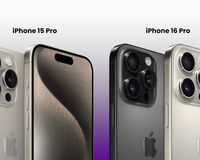With every product design, it's always a balancing act. Go too far in one direction, and you mess up something else. Apple's latest experiment? The iPhone Air. Seriously thin, and maybe more about showing off design skills than a traditional upgrade. It’s thinner than a number two pencil. Thinner than the iPhone 6 (yes, the one that bent). Thinner even than the iPod Touch. That is wild. And yet, Apple has managed to pack in most of what makes an iPhone… an iPhone. So, should you buy the iPhone Air? Let’s talk about the design, the compromises, and whether this featherlight iPhone actually makes sense for you.
Design & Build: Featherlight, Futuristic, and Fingerprint-Friendly
Apple didn't just make a smaller iPhone. They basically rebuilt the whole thing inside. Most of the compute and memory is packed up top in what they call a “plateau", leaving the ultra-slim lower half entirely dedicated to battery.
What you get is an iPhone that feels unreal. It's way lighter and slimmer than what we're used to. The titanium frame keeps it durable, but it does attract fingerprints like crazy. The edges are softly rounded, giving it that smooth "slip it in your pocket and forget it's there" vibe.
For once, the Air name actually feels earned.
The Small Trade-Offs You’ll Notice
Making a phone this thin means sacrifices. Some are small annoyances, others are deal-breakers depending on how you use your phone. Let’s start light:
Speakers (Or Lack of Them)
The iPhone Air only has one speaker - in the earpiece. The bottom grills? Just microphones. That means audio sounds a little tinny, there’s no stereo separation in landscape, and if you block the earpiece with your thumb… silence. Not great, not terrible, just “fine.”
eSIM Only
To save space for the battery, Apple for rid of the SIM card slot. That nets about 200mAh of extra juice, but it’s a pain if you swap SIMs often or use carriers that don’t fully support eSIM. Most people will only notice this when they first set up the phone and when they eventually upgrade again.
No mmWave 5G
Unlike the rest of the iPhone 17 lineup, the Air doesn’t support mmWave 5G. Honestly? Almost no one will care. Even in the U.S., mmWave coverage is rare.
USB-C… Still USB 2
It’s 2025 and Apple is still putting USB 2 transfer speeds in a $999 phone. Enough said.
Medium Concerns: Things That Might Bother You
Heat & Performance
The iPhone Air has a fast A19 Pro chip (with one less GPU core than the Pro models). But here’s the catch: the Air has no vapor chamber, no fancy thermal conductivity, and a thinner body. Translation? It gets warm. You’ll feel the heat around the camera plateau when playing games or recording videos for a while. It does throttle under stress, though it never outright overheated in my testing.
Single Camera Life
This is a big one. The Air only has one rear camera. No ultra-wide, no telephoto. Just the main one. For casual shooters, it’s great - sharp, bright, and very Apple. But if you’re used to zooming in or capturing wide landscapes, you’ll feel the loss fast.
Apple leans hard on 2x crop tricks, but past 5x zoom, quality drops off. And while the selfie camera is genuinely impressive (one of Apple’s best upgrades this year), the missing versatility hurts compared to other $1,000 phones.
The Big Concerns: Where It Really Hurts
Durability (Surprise: It’s Amazing)
This is the shocker. Everyone assumed a phone this thin would bend like a Pringle. Instead, it’s one of the most durable iPhones ever.
The titanium frame flexes but snaps back flat. The Ceramic Shield 2 glass shrugged off scratch tests that would normally mark up other phones. It’s still IP68 water and dust resistant, and repairability scored a 7/10 with iFixit thanks to Apple’s new dual-entry design.
So yeah - durability isn’t a weakness. It’s one of the iPhone Air’s biggest strengths.

Battery Life (The Weak Link)
Here’s the real deal-breaker. The iPhone Air has a battery roughly the size of the iPhone 11’s powering a big, bright, 120Hz OLED. That math doesn’t add up.
In daily use, I got about 4 hours of screen-on time, usually limping to bedtime on 15% in Low Power Mode. That’s… not great. And since it also charges slower than the other iPhone 17 models, topping up feels frustrating.
Apple’s solution? A $99 MagSafe battery pack that charges the Air to about 65%. Honestly, it feels more like a band-aid than a fix.
If you’re a light user, you’ll survive. If you’re a power user, you’ll be chained to chargers.
Who Should Actually Buy the iPhone Air?
The iPhone Air is for people who care about how a phone feels in the hand more than how long the battery lasts. It’s for your parent who takes most photos on the main lens and loves a slim device. It’s for someone who wants the “Air” aesthetic - light, minimal, beautiful - and isn’t constantly gaming, filming, or running their phone at max brightness.
If you’re a heavy user, creator, or battery worrier, skip this and grab a Pro.
The Future: A Foldable Warm-Up?
There’s a strong argument that the iPhone Air isn’t just a product, it’s a test. All this miniaturisation, custom chips, and efficiency work feels like Apple paving the way for a foldable iPhone.
Foldables need to be super thin when open so they don’t feel like bricks when closed. And right now, half a Galaxy Z Fold is thinner than this iPhone. The Air might be a preview of what Apple is cooking for 2026: the first truly new iPhone form factor since the X.

Verdict: Should You Buy the iPhone Air?
The iPhone Air is Apple showing off. It’s stunning, light, and surprisingly durable. Pick it up, and you’ll fall in love with how it feels instantly. But love comes with conditions: you’ll live with weaker speakers, one camera, and most importantly, mediocre battery life.
Buy the iPhone Air if:
- You want the thinnest, lightest iPhone ever.
- You mostly use the main camera.
- You’re a light or moderate phone user.
Skip it if:
- You need all-day battery.
- You want versatile cameras.
- You rely on fast transfers or heavy gaming.
For me? The Air is fascinating, but I’m sticking with the Pro. The best thing about the Air might be how it frees up the Pro models to go all-in on battery, performance, and cameras.
It’s a gorgeous experiment, but one you should only buy if you know exactly what you’re trading off
If this doesn’t put you off, sign up to get notified when the full iPhone 17 range and the new iPhone Air go live here.
If the new phone isn't for you, check out our other refurbished iPhones here.

![The Best iPhones for battery life ranked [2025]](http://reboxed.co/cdn/shop/articles/IPHONE-BATTERY_e2de6230-b1d2-4348-ac33-e47d1e267bdd_100x80_crop_center@2x.jpg?v=1738489925)






